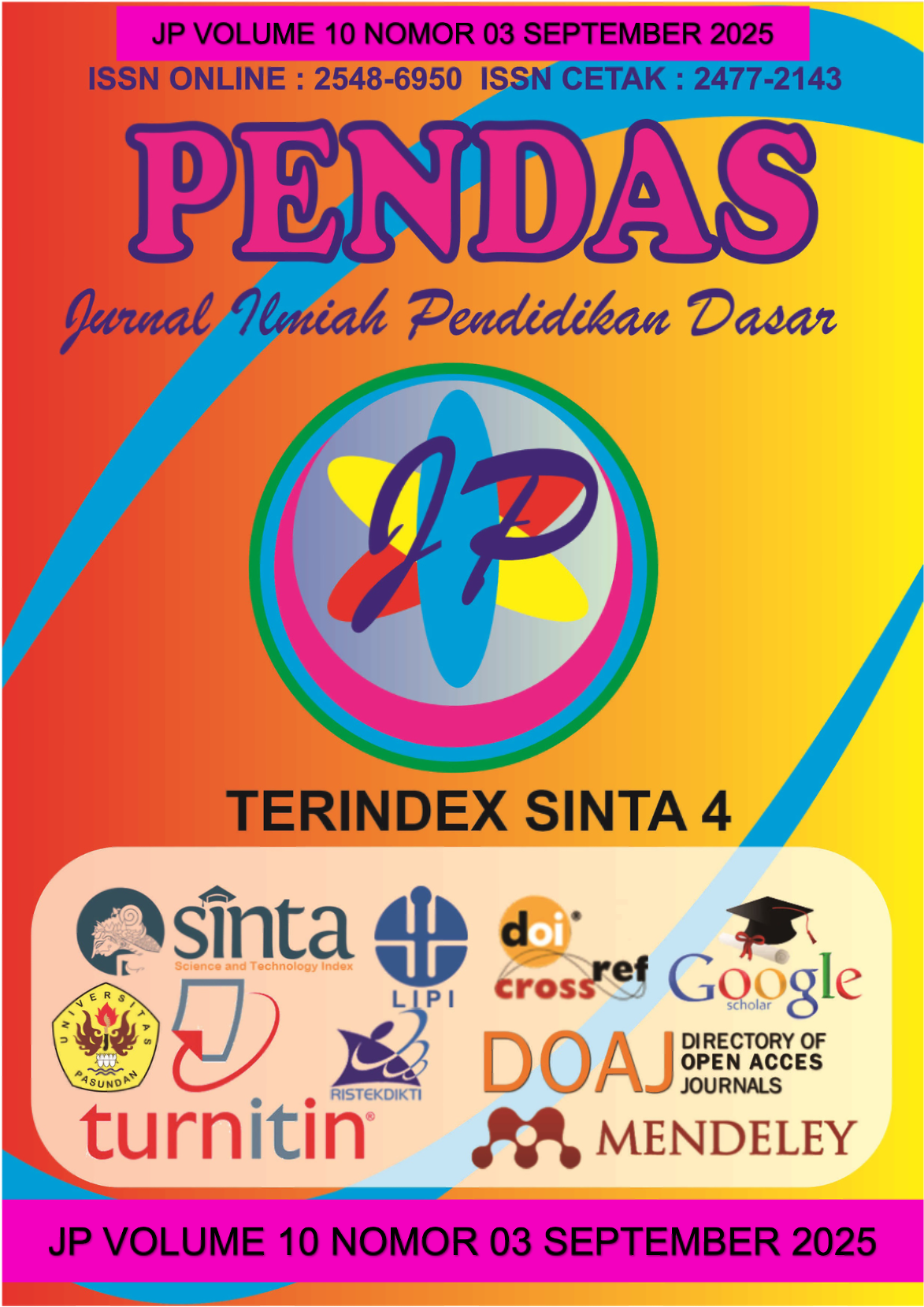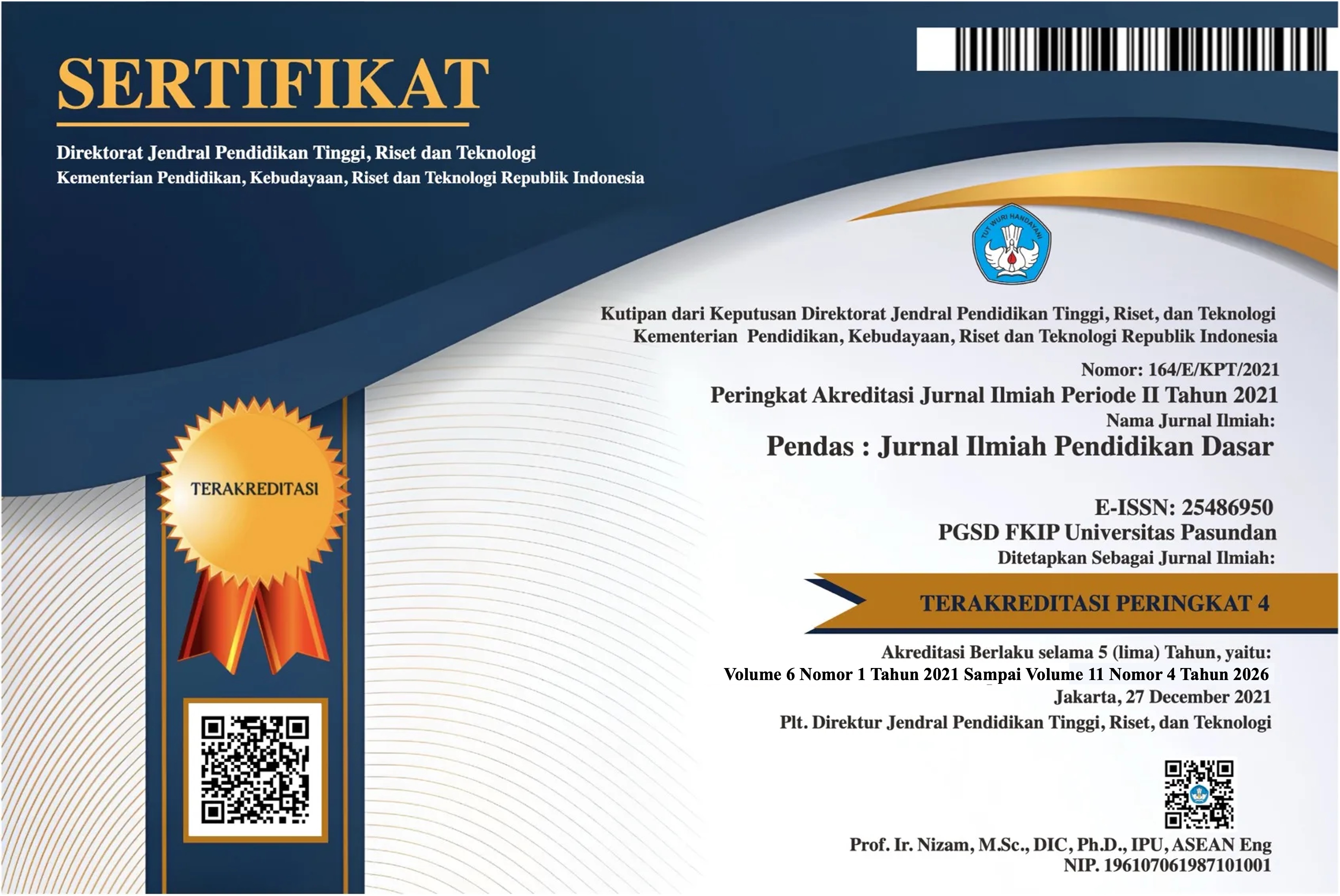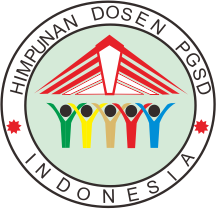PENGGUNAAN MODEL PEMBELAJARAN PROBLEM BASED LEARNING BERBANTUAN MEDIA VIDEO UNTUK MENINGKATKAN HASIL BELAJAR SISWA PADA MATERI IPAS INDONESIAKU KAYA HAYATINYA DI KELAS V SD NEGERI OEBOBO 1 KOTA KUPANG
Keywords:
Problem Based Learning, Biodiversity, Learning OutcomesAbstract
This study, conducted by Delphy Martni Selan, is entitled “The Use of Problem-
Based Learning Model Assisted by Video Media to Improve Student Learning
Outcomes on the IPAS material ‘My Indonesia is Rich in Biodiversity” in Class V of
SD Negeri Oebobo 1, Kupang City”. The pusose of the research was to improve
student learning outcomes through the application of the Problem-Based Learning
model supported by video media. The research question was: How can the use of
the Problem-Based Learning model assisted by video media improve student
learning outcome on the IPAS material “My Indonesia, Rich in Biodiversity”? This
research employed Classroom Action Research (CAR), which consisted of four
stages: planning, implementation, observation and tests, and reflection. The
subjectsof the study were 34 fifth-grade students of SD Neger Oebobo 1. Data
were collected through observation and test tec hniques, and anlyed using
descriptive qualitative and quantitative approaches. The findings indicated that in
cycle I, 25 students (74%) achieved mastery, while 9 students (26,47%) didi not.
Students who suceeded paid attention to the teacher’s explanation, cooperatedin
groups, presented discussion results, and were able to compete worksheets and
test corrrectly. Meanwhile, students who failed tended to be inatentive, played
during lesson, and were unable to complete worksheets or tests properly. In cycle
II, significant improvement was observed, with 32 students (94%) achieving
mastery. These students demonstrated greater focus, stronger collaboration,
active participation in discussions, confidence in completing evaluation tests.
However, 2 students (5,88%) had not yet achieved mastery, as they were self-
focused and less attentive to the teacher’s explanations.
Downloads
References
minimal 75. Sementara itu, 18 siswa
(52,9%) lainnya belum mencapai
ketuntasan. Kondisi ini
memperlihatkan bahwa sebagian
besar siswa mengalami kesulitan
memahami materi, kurang aktif
bertanya maupun berdiskusi, dan
cenderung pasif menerima informasi.
Pelaksanaan siklus I dengan
penerapan model Problem Based
Learning berbantuan media video
menunjukkan adanya peningkatan
hasil postest memperlihatkan bahwa
sebanyak 25 siswa (74%) berhasil
mencapai ketuntasan, sementara 9
siswa lainnya (26%) masih belum
tuntas. Kenaikan ini menunjukkan
adanya dampak positif penerapan
PBL dengan media video dalam
meningkatkan hasil belajar. Namun
demikian masih terdapat kelemahan,
seperti beberapa siswa yang kurang
memperhatikan penjelasan guru, asyik
sendiri, tidak mau bekerjasama dalam
kelompok, dan belum mampu
menyelesaikan LKPD dengan baik.
Hasil observasi pada siklus I
juga memperlihatkan bahwa aktivitas
guru dalam mengelola pembelajaran
tergolong baik, meskipun masih ada
kekurangan dalam hal ketegasan
mengatur kelas dan pengelolaan
waktu. Aktivitas siswa juga
menunjukkan peningkatan dibanding
kondisi awal, tetapi sebagian siswa
masih pasif, belum optimal dalam
berdiskusi, dan kurang percaya diri
menyampaikan pendapat.
Berdasarkan refleksi dari siklus
I, dilakukan perbaikan pada siklus II,
yaitu dengan menegaskan aturan
kelas, memotivasi siswa untuk lebih
aktif berdiskusi, memberikan arahan
yang lebih jelas dalam penggunaan
LKPD, serta memaksimalkan
pemanfaatan video sebagai stimulus
pembelajaran. Hasil postest pada
siklus II menunjukkan adanya
penignkatan yang lebih signifikan. Dari
34 siswa, sebanyak 32 orang (94%)
dinyatakan tuntas belajar, sementara
hanya 2 siswa (5,88%) yang masih
belum mencapai KKTP. Siswa yang
tuntas umumnya sudah mampu
bekerja sama dalam kelompok, berani
mengemukakan pendapat, aktif
bertanya, serta mampu
menyelesaikan soal evaluasi dengan
tepat.
Observasi terhadap aktivitas
gurupada siklus II menunjukkan
peningkatan dibandingkan siklus I.
guru lebih mampu mengatur jalannya
diskusi, mengelola waktu dengan baik,
serta menguasai kelas secara efektif.
Aktivitas siswa juga meningkat
Downloads
Published
Issue
Section
License
Copyright (c) 2025 Pendas : Jurnal Ilmiah Pendidikan Dasar

This work is licensed under a Creative Commons Attribution 4.0 International License.



















